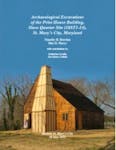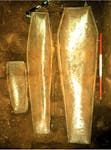Reports & Studies
Technical Reports on the Research at Historic St. Mary’s City
To obtain access to the reports listed below, contact travis.parno@maryland.gov

Salvage Archaeology of a Dwelling on the John Hicks Leasehold, St. Mary’s City, Maryland (Part 1) and A Preliminary Archaeological and Historical Study of the Residents of the Post Capital Era of St. Mary’s City, Maryland (Part 2)
by Lois Green Carr, J. Glenn Little, and Stephen S. Israel (1971; new digital edition with updated introduction and errata, 2023).
This file combines both volumes of the original 1971 report, with improved figures, a new introduction, and an errata sheet correcting errors in the original printing. It details the archaeology and artifact analyses of the mid-18th-century plantation of Captain John Hicks, a ship captain, merchant, and planter. Hicks held 19 enslaved people. Excavations revealed Hicks’ earthfast dwelling, a cellar, and numerous pits and other features in the vicinity of the house. Excavators recovered a rich assemblage of artifacts that provide valuable insight into the lifestyle of the rural elite during the third and fourth decades of the eighteenth-century. Historical analysis places Hicks into the social context of major Southern Maryland plantation owners during this period. This was the first archaeological investigation sponsored by Historic St. Mary’s City, and the earliest comprehensive study of a plantation from this period in Maryland.

Archaeological Excavations of the Print House Building,
Slave Quarter Site (18ST1-14)
by Timothy B. Riordan and Silas D. Hurry with contributions by Katherine Cavallo and Sara Rivers Cofield (2015).
This color illustrated publication is 149 pages with 86 figures and 32 tables. It details the archaeology and artifact analyses of this significant site in Maryland’s first capital. Included are discussions of the architecture and an analysis of both the printing type recovered and the wide array of ceramics represented.

Journal of Archaeological Science:
Pollen Analysis of Three Seventeenth-Century Lead Coffins
by Gerald K. Kelso and Henry M. Miller (2016).
Three lead covered wooden coffins containing the remains of a man, a woman, and a child were found during excavations inside the foundation of the 17th-Century Jesuit Chapel at Historic St. Mary’s City, Maryland. The objectives of the lead coffins pollen analysis were to determine the season of burial of the bodies and to recover evidence of plants employed in the interments.

Creative Adaptation: Exhibitions in the Downturn
by Regina Faden, Ph.D., Executive Director of Historic St. Mary’s City
The recent economic downturn has compelled HSMC to develop innovative approaches to create interpretive exhibitions within a tightly constrained budget. The main method of adjusting to limited funds is by mining the museum’s current internal resources of skilled and talented staff members.
